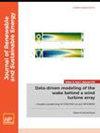Ancillary services from wind and solar energy in modern power grids: A comprehensive review and simulation study
IF 1.9
4区 工程技术
Q4 ENERGY & FUELS
引用次数: 0
Abstract
Renewable energy sources like wind and solar have increased demand for surplus power capacity. The demand is primarily fueled by the growing impact of forecasting errors associated with these intermittent energy sources. Implementing advanced control methods for automatic generation control (AGC) is essential to integrate wind and solar power with conventional generation sources to balance the power system and reduce reliance on traditional reserves. Therefore, this paper comprehensively overviews solar and wind energy integration in the AGC framework to provide optimal grid ancillary services. Initially, the paper presents an overview of the basic equations used to integrate reserve power from the photovoltaic (PV) system by employing the de-loading strategy. Subsequently, a comprehensive review is conducted on integrating the PV system in AGC strategies to provide grid ancillary services. The study also analyzes the contribution of wind power in AGC services using relevant equations and past practices. The paper presents a real-time dynamic control strategy to optimize the dispatch of the AGC unit by integrating the operating reserves from wind energy systems in conjunction with thermal power systems. The study simulates an 8-bus, 5-machine model using the Dig-SILENT Power Factory. The findings reveal that utilizing operating reserves from wind power can significantly reduce large-scale forecasting errors in massively renewable energy resources (RES) integrated power systems, thereby ensuring the necessary system operational security and reducing the reliance on traditional generating units.现代电网中的风能和太阳能辅助服务:全面回顾与模拟研究
风能和太阳能等可再生能源增加了对剩余发电能力的需求。造成这种需求的主要原因是,与这些间歇性能源相关的预测误差的影响越来越大。实施先进的自动发电控制 (AGC) 控制方法对于将风能和太阳能与传统发电资源整合以平衡电力系统和减少对传统储备的依赖至关重要。因此,本文全面概述了 AGC 框架下的太阳能和风能集成,以提供最佳电网辅助服务。首先,本文概述了采用去负载策略整合光伏系统储备电力的基本方程。随后,全面回顾了将光伏系统纳入 AGC 策略以提供电网辅助服务的情况。研究还利用相关方程和以往实践分析了风能在 AGC 服务中的贡献。论文提出了一种实时动态控制策略,通过整合风能系统与火电系统的运行储备来优化 AGC 机组的调度。研究使用 Dig-SILENT Power Factory 模拟了一个 8 总线、5 台机器的模型。研究结果表明,在大规模可再生能源(RES)集成电力系统中,利用风力发电的运行储备可以显著减少大规模预测误差,从而确保必要的系统运行安全,减少对传统发电机组的依赖。
本文章由计算机程序翻译,如有差异,请以英文原文为准。
求助全文
约1分钟内获得全文
求助全文
来源期刊

Journal of Renewable and Sustainable Energy
ENERGY & FUELS-ENERGY & FUELS
CiteScore
4.30
自引率
12.00%
发文量
122
审稿时长
4.2 months
期刊介绍:
The Journal of Renewable and Sustainable Energy (JRSE) is an interdisciplinary, peer-reviewed journal covering all areas of renewable and sustainable energy relevant to the physical science and engineering communities. The interdisciplinary approach of the publication ensures that the editors draw from researchers worldwide in a diverse range of fields.
Topics covered include:
Renewable energy economics and policy
Renewable energy resource assessment
Solar energy: photovoltaics, solar thermal energy, solar energy for fuels
Wind energy: wind farms, rotors and blades, on- and offshore wind conditions, aerodynamics, fluid dynamics
Bioenergy: biofuels, biomass conversion, artificial photosynthesis
Distributed energy generation: rooftop PV, distributed fuel cells, distributed wind, micro-hydrogen power generation
Power distribution & systems modeling: power electronics and controls, smart grid
Energy efficient buildings: smart windows, PV, wind, power management
Energy conversion: flexoelectric, piezoelectric, thermoelectric, other technologies
Energy storage: batteries, supercapacitors, hydrogen storage, other fuels
Fuel cells: proton exchange membrane cells, solid oxide cells, hybrid fuel cells, other
Marine and hydroelectric energy: dams, tides, waves, other
Transportation: alternative vehicle technologies, plug-in technologies, other
Geothermal energy
 求助内容:
求助内容: 应助结果提醒方式:
应助结果提醒方式:


